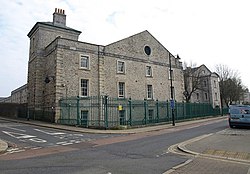Stonehouse Barracks
| Stonehouse Barracks | |
|---|---|
| Plymouth | |

Stonehouse Barracks
|
|
|
Location within Devon
|
|
| Coordinates | 50°22′02″N 4°09′45″W / 50.36713°N 4.16238°WCoordinates: 50°22′02″N 4°09′45″W / 50.36713°N 4.16238°W |
| Type | Royal Marines Base |
| Site information | |
| Owner | Ministry of Defence |
| Operator | Royal Navy |
| Site history | |
| Built | 1756 |
| Built for | Admiralty |
| In use | 1756-Present |
| Garrison information | |
| Occupants | 3 Commando Brigade |
Stonehouse Barracks is a military installation at Stonehouse, Plymouth. It is the home of 3 Commando Brigade and referred to by commandos as 'the spiritual home of the Royal Marines'.
The earliest parts of Stonehouse Barracks date from 1756, but the main phase of construction was undertaken between 1779 and 1785 by James Templer and Thomas Parlby, with later additions in the 19th century. The barracks were known in the early 19th century as Mill Bay Barracks.
The buildings became the headquarters of the Plymouth Division of the Royal Marines. Although the divisional structure of the Royal Marines was dismantled during the Second World War, the barracks remain in use as headquarters of 3 Commando Brigade.
RM Stonehouse also accommodates the Plymouth Division of the Royal Marines Volunteer Cadet Corps, since their formation in 1904. The VCC currently has over 100 cadets and is open to boys and girls aged 9 to 16 (who can serve until aged 18) from the Plymouth and south Devon area.
Since the Corps' foundation in 1664, Marines have been quartered in Plymouth. Following their formation into three divisions in 1775, His Majesty's Marine Forces became the first corps in Britain to be fully accommodated in their own barracks, which were established in the three divisional towns of Chatham, Portsmouth and Plymouth; Stonehouse is the only one of these to have survived.
The barrack range on the east side of the parade ground, together with short officers' blocks to the north and south, formed the core of the original 1780s barracks complex; it is said to be one of the earliest surviving barracks for a large unit of men in England. The south range was extended, and the north entirely rebuilt, as part of the expansion of the barracks in the 1860s. The archway block on Durnford Street, which closes off the eighteenth-century quadrangle, also dates from this period (1867-71); the range consists of a series of officers' houses and administrative offices with a chapel (originally a schoolroom) above the central entrance arch. A rare survival from the 1830s is a former racquet court, which was later converted into a theatre.
...
Wikipedia


